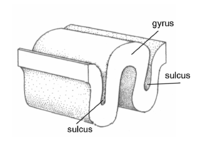
Photo from wikipedia
The angular gyrus (AG), given its rich connectivity and its location where multisensory information converges, is a functionally and anatomically heterogeneous structure. Using the state‐of‐the‐art functional gradient approach and transcription‐neuroimaging… Click to show full abstract
The angular gyrus (AG), given its rich connectivity and its location where multisensory information converges, is a functionally and anatomically heterogeneous structure. Using the state‐of‐the‐art functional gradient approach and transcription‐neuroimaging association analysis, we sought to determine whether there is an overarching hierarchical organization of the AG and if so, how it is modulated by the underlying genetic architecture. Resting‐state functional MRI data of 793 healthy subjects were obtained from discovery and validation datasets. Functional gradients of the AG were calculated based on the voxel‐wise AG‐to‐cerebrum functional connectivity patterns. Combined with the Allen Human Brain Atlas, we examined the spatial correlations between the AG functional gradient and gene expression. The dominant gradient topography showed a dorsoanterior–ventroposterior hierarchical organization of the AG, which was related to its intrinsic geometry. Concurrently, AG functional subdivisions corresponding to canonical functional networks (behavioral domains) were distributed along the dominant gradient in a hierarchical manner, that is, from the default mode network (abstract cognition) at one extreme to the visual and sensorimotor networks (perception and action) at the other extreme. Remarkably, we established a link between the AG dominant gradient and gene expression, with two gene sets strongly contributing to this link but diverging on their functional annotation and specific expression. Our findings represent a significant conceptual advance in AG functional organization, and may introduce novel approaches and testable questions to the investigation of AG function and anatomy in health and disease.
Journal Title: Human Brain Mapping
Year Published: 2023
Link to full text (if available)
Share on Social Media: Sign Up to like & get
recommendations!